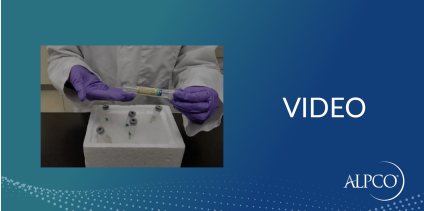February 26, 2019
How to Properly Collect and Handle GLP-1 Samples
We know that the proper collection and handling of samples is vital for accurately measuring GLP-1.
ALPCO is here to help your lab reduce technical errors and improve assay results when running the STELLUX® Chemi Active GLP-1 (7-36) amide ELISA.
Watch our video to learn how to properly collect and handle GLP-1 samples for more accurate results.
https://youtu.be/j6_YgA2NCO8
Video Transcript
Hello and thank you for joining us! In our previous video, we discussed how active GLP-1 (7-36) amide is easily degraded by DPP-4, causing issues with accurately measuring the hormone. Today, we will focus on how to collect and handle active GLP-1 (7-36) amide samples in order to preserve the hormone and reduce pre-analytical variability when running the STELLUX® Active GLP-1 (7-36) amide ELISA. ALPCO’s team of R&D scientists have shared their expert knowledge with us to help ensure you obtain the best results possible with your assay. One more thing before we jump in - Be sure to download the PDF version of this GLP-1 sample handling and collection guide where we share links to all the lab materials we reference and use in-house at ALPCO when measuring GLP-1.Preserving Active GLP-1 (7-36) amide
To help preserve active GLP-1 (7-36) amide in samples, your main goal is to prevent degradation by the enzyme DPP-4. This is mainly accomplished by:- Using the proper sample collection materials
- Performing the steps at the optimal temperature and
- Completing steps within the recommended time
Active GLP-1 (7-36) amide Sample Collection Materials
First, it is imperative to use the proper sample collection materials to ensure that active GLP-1 (7-36) amide is not degraded upon sample collection1. At ALPCO, we collect samples using the BD™ P800 Blood Collection and Preservation System which contains DPP-4 inhibitor and a cocktail of other protease inhibitors. Alternatively, you can collect whole blood into ice-cooled, EDTA tubes with the addition of 10 µL of DPP-4 inhibitor and 500 KIU of aprotinin per 1 mL of whole blood.Active GLP-1 (7-36) amide Post-Collection Sample Handling
Next, you’ll want to remember that handling the samples incorrectly post-collection can also affect pre-analytical variability1. It’s important to keep in mind that maintaining samples at the optimal temperature assists with preserving GLP-1. So, after sample collection, we suggest you keep your samples on ice to further reduce DPP-4 activity. We’ve determined that for EDTA plasma samples, you need to centrifuge within 1 hour of sample collection at 1000 x g for 10 minutes at 2-8˚C. If your samples will be tested within 2 hours following collection, you can keep them on ice in the meantime.Active GLP-1 (7-36) amide Sample Storage
Improper long term storage temperature can also lead to pre-analytical variability when quantifying active GLP-1 (7-36) amide levels. If you are not going to run your EDTA plasma samples within 2 hours, we recommend you aliquot and store samples at ≤ -20°C to avoid variability issues. Research indicates that when samples are handled appropriately, active GLP-1 (7-36) amide can be stable for at least 1 year1. However, if your samples are frozen for long term storage, it is important not to subject them to multiple freeze thaw cycles because this can cause active GLP-1 to degrade as well. To preserve samples at ALPCO, we limit our freeze thaw cycles to no more than 3.Final Active GLP-1 (7-36) amide Sample Preparation
Finally, no matter if your samples are going to be kept for short or long term storage, all samples must be centrifuged at 3,000 x g at 2-8°C for 10 minutes before loading them on to the plate. And there you have it! By using the proper sample collection materials, maintaining optimal temperature, and completing steps within the recommended time frame, you can preserve your active GLP-1 samples and reduce pre-analytical variability. Following these sample collection and handling steps prior to running our STELLUX® Active GLP-1 (7-36) amide ELISA will enable you to accurately measure GLP-1.References
- Wewer Albrechtsen, et al (2015). Stability of glucagon-like peptide 1 and glucagon in human plasma. Endocrine Connections, 4:50-57. PMID: 25596009.

